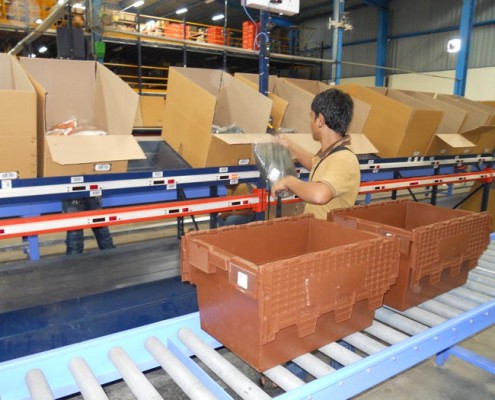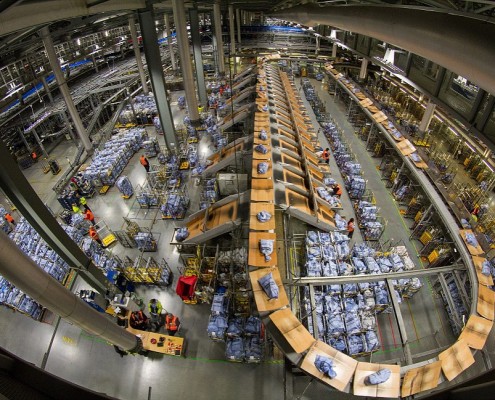WISE – WAREHOUSE SLOTTING SOFTWARE
WISE – Warehouse Slotting Software uses AI and ML technologies to perform dynamic slotting with precision results. Some of the Advantages of Slotting is an Estimated savings of 8 to 15% on manpower cost. Proposed cost saving of ~ 10 to 30% on space occupied, based on the inventory, the best place for storage will be determined.
Benefits of WISE – Warehouse Slotting:
- The Occupancy ratio will be increased
- Improvement in picking productivity
- Optimized Picking
- The bottleneck in inventory picking will be reduced
- Replenishment runs will be minimized
- Depending on the cargo size right type of pick slots can be formed
- Accommodate as per seasonal shifts in demand for cargo
- Uses the Most Easily Accessible slot
- Reduce Picking and Travel Time
- Reduce Number of Replenishments
- Reduce Manual Data Entry
- Identify Fast Moving Items
WAREHOUSE SLOTTING OBJECTIVES:
Warehouse Slotting is the process of determining the best location in a warehouse to store faster-moving items that are picked frequently by dedicating certain easily accessible locations that are closer to the Shipping/Packing areas. Slotting can be applied to dedicated pick locations (Pick-face) locations or generally to all locations.
Objectives:
- Improve storage efficiency
- Increase picking efficiency
- Optimization of spaces in the warehouse
- Reduction of handling cost.
“In the 12 years that WISE has been supporting the logistics operations at Poiesz, WISE has proven itself as a stable Warehouse Management System for our supermarket distribution centers. A WMS in which you can quickly configure thanks to the flexibility of the application.”

“There are two things I look at when reviewing software systems – functionality and after-the-sale support. The WISE warehouse management system has provided superior functionality to our Distribution group since 2002. Royal 4 is the “gold standard” I use for evaluating vendor support.”

WISE – Warehouse Slotting – Improves: Work Balancing
By balancing activity across multiple pick areas based on the number of picks per day you reduce congestion in the areas. WISE will have the ability to review items by ABC and by the number of picks. WISE can then take a location range and spread out the items based on the number of picks. An example would be every 5th location place a high moving pick. Or you could set it up by having a round-robin of 3 A items 2 B Items…
WISE – Warehouse Slotting – Manages: Seasonal Items
This can be done by running a date range. You will capture a date range in WISE by item or product group and export it to an excel spreadsheet, where you will be able to show spikes and decline of items during a specific time frame.
Slotting – By Forecasting
Takes the sales projection by the month for an item and slots accordingly. The Royal 4 “current sales forecast tool” will provide the projected sales of items. If the item is new it can be used to calculate the usage, the same way we calculate number picks. If the item has picking historical data, we can then compare actual versus forecast, to come up with a blend for slotting.
ABC CLASSIFICATION PROCESS:
A number of data elements and inputs are required for an effective slotting algorithm, some can be calculated by the system and some need to be maintained by the user. The parameters include: From/To a range of Dates, Data Source using either Picking tasks or Packing tasks and Method: Number of Tasks or by Quantity. Inventory will be classified by ABC classification.

GOLDEN AREA
Definition of primary locations (Golden Area) is done in WISE by maintaining the correct table and works fine for re-slotting of existing pick-faces. The primary locations may include floor level locations, flow racks, cross dock locations or locations very close to shipping area, or locations that are faster to pick from.

INVENTORY HISTORY
The historical time frame is used to analyze movement. This is best done with a date range to allow you to look at as much or as little data as you want and to allow you to look at specific disconnected periods for seasonality (for example run for last summer to get this summer’s re-slotting).

LOCATIONS
The item cube, pallet, each, case quantity, and location capacity. This information is mostly already in WISE and can be used (if available) to decide the min/max quantity and the number of dedicated slots (locations).

RESERVE INVENTORY
Definition of the reserve amount required. For example you can ask for a full day worth of product so replenishments are done once a day. The larger this number the more space is required for an item and fewer items can have dedicated locations. A rolling average over a period time of time should be taken into consideration. This levels out the average amount of inventory needed on a daily bases which will eliminate over utilization of a pick face.

FORWARD PICKING
Reduce number of replenishments required by storing enough quantity of a fast moving item in the primary pick area.

SLOTTING CALCULATIONS
The slotting screen holds the result of the slotting calculations and allows you to add or change data as needed. Your changes may be needed for items that the system does not have sufficient information about and would not have in the results, such as new items, Special promotions, and discontinued items. The table has the location number, current item number, current MIN/MAX, future suggested location.

ID FAST MOVERS
Definition of what is a fast moving item, this can be done by number of picks (which is most common) or total quantity picked.







